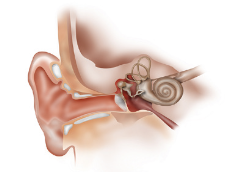Types of hearing loss

The Ear
The pinna is the outer part of the ear which catches waves of sound and directs them down into the ear canal. These sound waves cause the eardrum to vibrate which travels across the middle ear by three very small bones: The malleus, incus and stapes (Ossicular chain). The 3 middle ear bones increase the strength of these vibrations before they pass through the oval window into the cochlea in your inner ear. The cochlea looks very similar to a snail`s shell and is filled with fluid and contains thousands of hair cells. When the vibrations enter the cochlea, this causes the fluid and hair cells to move. These hair cells move and create an electrical charge signal. The auditory nerve carries these signals to the brain where they are then understood as sound. For the ear to work efficiently all these described parts of the ear mechanism must work well. Deafness is caused when one or more parts of the hearing mechanism are not working correctly.
Types of Hearing Loss
Hearing loss can be detected in one ear (unilateral deafness) or both ears (bilateral deafness) and can be congenital (deaf from birth) or acquired (occurs or develops at some point during a person’s life).
Conductive deafness:
A conductive hearing loss is caused when sound is unable to pass directly through the outer and middle ear to the cochlea and auditory nerve. The most common cause of a conductive hearing loss is otitis media (glue ear). Glue ear is a buildup of fluid in the middle ear. Most children can grow out of glue ear and will not require any treatment. Some children, however, do suffer with long-term glue ear where hearing aids may be an option; or the child may possibly need grommet surgery. Grommets are very small plastic tubes which are inserted into the eardrum. Grommets help to keep the middle ear ventilated helping to prevent further fluid buildup.
Sensorineural deafness:
Sensorineural deafness is when there is a fault in the inner ear, quite often because the hair cells in the cochlea are not working correctly. The auditory nerve can also be responsible for sensorineural deafness. A sensorineural hearing loss is permanent. Some people who have sensorineural deafness may also have a conductive hearing loss such as glue ear which would then be described as a mixed deafness.